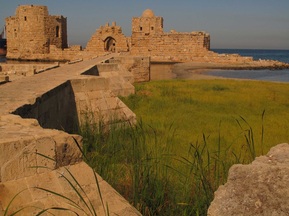- Visit Lebanon

- South Lebanon

- Saida (Sidon)
Saida (Sidon)

Located about 45 kilometers south of Beirut and Lebanon’s southern commercial and governmental center, Saida is a pleasant and laid-back port city. Unfortunately, many of its Phoenician remnants have been lost to fire and theft or reside under newly constructed buildings.
In the Old Testament, Saida is referred to as the first born of Canaan, the ancestor of the tribes who originally occupied the ancient land of Canaan (nowadays Lebanon, Israel/Palestine, western Syria and parts of Jordan). Around 1200 BC, it was one of the most important Phoenician cities, internationally famous for its blown glass and purple dye extracted from murex (molluscs). Following Phoenician times, the city has been invaded and ruled by the Persians (550 BC), Greeks (330 BC), Romans (64 BC), Byzantines (395), Arabs (636), Crusaders (1111), Mamluks (1291), Ottomans and Fakhr el-Dine Maan II; each of them leaving their marks, some more visible than others. In September 1840, Saida was shelled by Austrian, British and Ottoman troops trying to wrest the city and its surrounding area from Egyptian control. After World War I, it became part of the French Mandate and when the Arab-Israeli war broke out in 1948, a considerable number of Palestinian refugees arrived in Saida, settling in the refugee camps of Ein el-Helwe and Mieh Mieh (see also Palestinian Refugee Camps). The old city suffered severely from an earthquake in 1956 and both the Civil War (1975 - 1990) and Israeli occupation of the south left considerable damage. Recent tensions in the city arose from the actions of Salafist Sheikh Ahmad Assir, an extremist Sunni Imam who opposes the presence of Hezbollah militia in the area. In 2012 and 2013, supporters and opponents of Assir clashed several times in Abra, a neighborhood in Saida housing the mosque of Sheikh Ahmad Assir. Given that Saida is the birthplace of Rafiq Hariri, a lot of effort was spent in reconstructing its historical buildings by Hariri’s post war Solidere foundation.
Now pre-dominantly Sunni, Saida is a must see for history lovers; the beautiful Crusader Sea Castle, the well-restored Khan al-Franj, the Ottoman-style Debbane Palace and the impressive mosques are all worth the experience. Combined with a stroll around the traditional Arabic souqs and a visit to the old soap factory, a full visit to Saida requires a day or two. Note that on Friday afternoons many sites might be closed, while over the weekend the city can become rather crowded.
